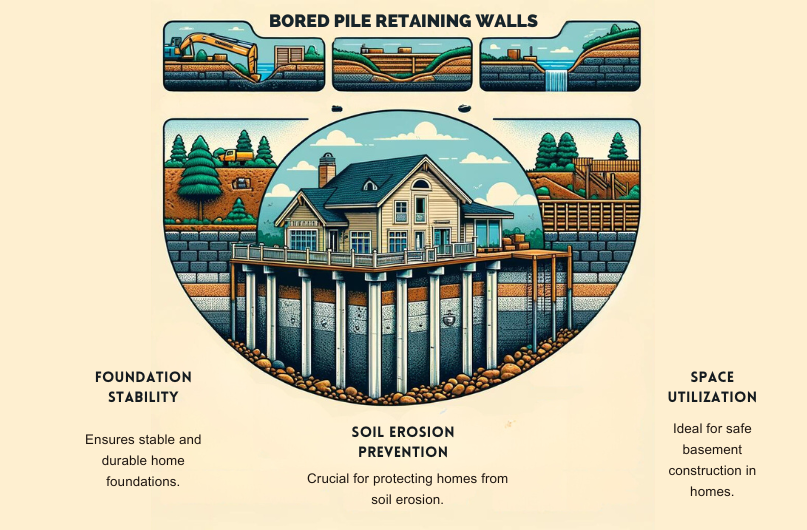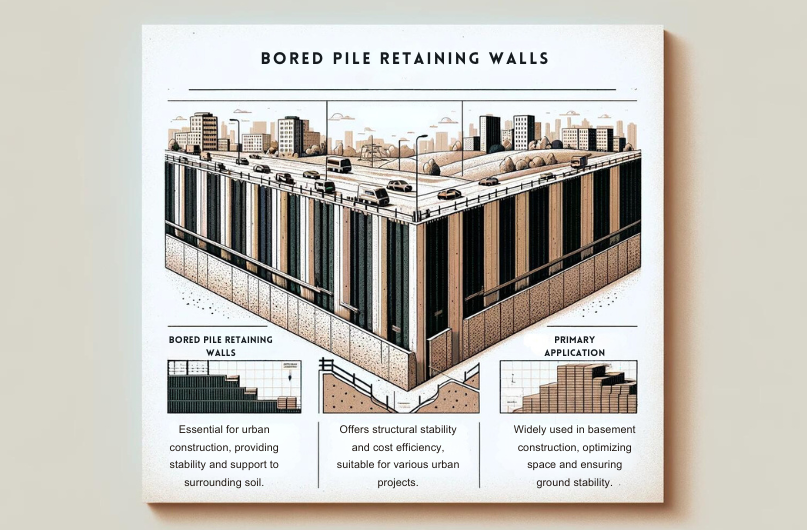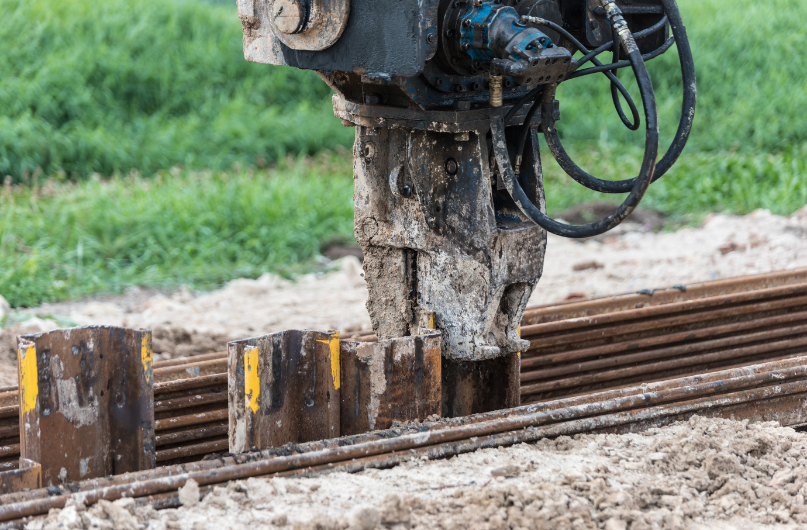If you've ever wondered how bored pile retaining walls function, imagine a system that not only supports but also stabilizes the earth around it.
These walls, created through a methodical process involving drilling and filling with concrete, play a crucial role in urban environments.
But how exactly do they manage to keep everything in place? Let's unravel the mystery behind these structures that silently safeguard their surroundings, offering a unique perspective on modern engineering solutions.

When considering bored pile retaining walls, one can't overlook their unparalleled adaptability to diverse design layouts, making them a prime choice for a range of construction needs. Cost efficiency is a significant advantage of bored pile retaining walls. These walls typically require minimal bulk excavation compared to other deep foundation systems, which helps reduce overall construction costs. Additionally, the installation of bored pile retaining walls in restricted spaces minimizes the need for extensive site preparation, further contributing to cost savings.
Moreover, bored pile retaining walls offer environmental benefits. Their ability to be constructed with different thicknesses based on specific site needs ensures that only the necessary materials are used, reducing waste. The minimal excavation required during installation also helps lessen the environmental impact of the construction process. In challenging ground conditions where traditional retaining wall systems may not be feasible, bored pile walls provide a sustainable solution that balances structural integrity with environmental consciousness.
To initiate the construction process of bored pile walls, drilling holes into the ground is the first critical step. This process involves specialized equipment and skilled operators to ensure the holes are of the correct diameter and depth.
Once the holes are drilled, the installation techniques for bored pile walls typically include:
Cost analysis for bored pile walls should consider factors such as equipment rental, labor costs, materials, and any additional stabilization measures required for the specific project.
Bored pile retaining walls function by strategically installing closely spaced bored piles to establish a robust structural barrier against soil movement. The design considerations for bored pile walls include factors such as the soil type, groundwater conditions, and the desired wall height.
The soil interaction plays a crucial role in the working mechanism of bored pile walls, as the frictional resistance between the soil and the pile shafts provides the necessary load-bearing capacity. By ensuring proper reinforcement with steel and filling the piles with concrete, these walls gain strength and stability to withstand lateral earth pressures effectively.
The interlocking arrangement of bored piles creates a continuous wall that resists soil movement and retains the surrounding earth. Bored pile walls offer versatility in design, allowing engineers to tailor the wall specifications to accommodate different soil conditions and structural requirements efficiently.

In urban construction projects requiring robust soil retention solutions, bored pile retaining walls serve as vital structural elements. These walls find extensive applications in various urban development projects due to their efficiency and effectiveness.
Here are some key applications of bored pile retaining walls:
The versatility and cost-effectiveness of bored pile walls make them a preferred choice for engineers and developers involved in urban development projects requiring robust soil retention solutions.
Factors influencing the design of bored pile walls include soil conditions, groundwater levels, and adjacent structures, all crucial in determining the structural integrity and stability of the retaining wall system.
The bored pile diameter, spacing, and reinforcement details are vital parameters in wall design, as they directly affect the load-bearing capacity and overall performance.
Additionally, factors such as wall height, excavation depth, and the required load-bearing capacity significantly influence the configuration of bored pile walls. Structural loads, construction sequence, and site constraints also play a pivotal role in determining the design specifics.
It's essential to consider construction methods, material availability, and project timeline during the design phase to ensure the successful implementation of bored pile retaining walls. By carefully evaluating these factors and incorporating them into the design process, engineers can create robust and efficient bored pile wall systems that effectively meet the project requirements.
When comparing bored pile retaining walls to other types, it becomes evident that each has distinct advantages and limitations in specific soil conditions and project requirements.
Bored pile walls offer greater depth capabilities compared to sheet piled walls, making them suitable for projects requiring deeper excavation support.
Secant walls and piles excel in water resistance, providing a more watertight solution compared to contiguous walls and piles, which is crucial in environments with high water levels. However, in cohesive soils, contiguous walls and piles are more cost-efficient than secant walls, offering a more economical option for certain projects.
King post walls stand out for their flexibility in shape and installation around obstructions, providing adaptability in challenging site conditions.
Bored pile walls, on the other hand, shine in their adaptability to different wall layouts and thicknesses, offering versatility in design configurations for various project needs.

To ensure the optimal performance and longevity of bored pile walls, regular inspection and proactive maintenance practices are essential components of a comprehensive asset management strategy. Preventive measures play a crucial role in identifying early signs of distress or potential issues, allowing for timely intervention.
Implementing proper maintenance, such as repairing concrete cracks and addressing drainage problems, can significantly extend the lifespan of bored pile walls. Additionally, the utilization of cathodic protection systems helps prevent corrosion of reinforcement bars, enhancing the overall durability of the structure.
A robust maintenance plan should include periodic cleaning, vegetation control, and structural assessments to ensure the long-term performance of bored pile walls. Addressing water infiltration and drainage issues promptly is vital to prevent water-related damage and maintain the stability and effectiveness of bored pile retaining walls over time.
When you think about bored piling, remember it's all about stabilizing soil and designing solid foundations. It's about enhancing load-bearing capacity for deep excavations. Bored piling ensures your structure stands strong on stable ground.
When dealing with bored pile construction, you may encounter challenges like soil stability issues affecting deep excavations. These problems can lead to cost overruns and construction delays, impacting the overall project timeline and budget.
When installing bored piles, you use specialized equipment to drill into the ground, displacing soil. This process involves precise drilling techniques to ensure proper pile installation. The equipment plays a crucial role in achieving the required depth for the piles.
When should you use bored piles? Utilize them for soil stability during construction. Ensure foundation stability with bored pile retaining walls. Opt for this technique in challenging ground conditions where traditional methods may not suffice.
In conclusion, bored pile retaining walls are an efficient and versatile solution for stabilizing excavations in urban areas with limited space. By transferring lateral soil pressures to the piles, these walls prevent collapse and maintain the stability of the surrounding soil.
With their effective construction process and wide range of applications, bored pile walls are a reliable choice for retaining structures in various ground conditions. Proper maintenance and attention to design factors ensure the longevity and effectiveness of these structures.